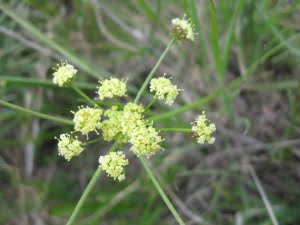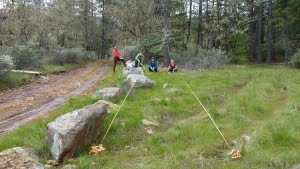Population Monitoring for Lomatium cookii
 |
| French Flat monitoring site |
The Klamath-Siskiyou wilderness region in Southern Oregon is well-known for its incredible biodiversity. As home to over 1,800 plants, 131 of which are endemic to the area, the Klamath-Siskiyous are a hotspot for botanical research and have seen increased interest and investment in restoration of the forests, river systems, and native plant communities. The Klamath-Siskiyou region contains the largest block of protected wildlands on the West Coast.
In addition to having serpentine soils, which many plant species cannot tolerate, the Klamath-Siskiyou region did not experience any glacial activity during the last ice age, making it an ice-free refugium for many plant species. One of the numerous endemic species present,
Lomatium cookii, is listed by state and federal authorities as endangered and has been monitored by IAE for nearly twenty years. Monitoring efforts have focused on identifying trends in population size and density in order to produce a population viability analysis and provide management recommendations for the BLM.
 |
| L. cookii inflorescence |
Lomatium cookii(commonly known as either Cook’s desert parsley or agate desert parsley) is a small perennial in the Apiaceae family that produces yellow umbellate flowers in early spring. It is similar in appearance to Bradshaw’s lomatium, an endangered species that occurs in the Willamette Valley. (
For more information on identification of L. cookii, click here.) In late April/early May of each year, IAE monitors three populations of
L. cookii within the Medford BLM district. Analysis of monitoring results indicates that the population sizes have remained fairly stable and that there has been an increase in seedling recruitment. However, some of the populations are physically limited by mine tailings, land disturbance, and hydrologic manipulation caused by placer mining that occurred in the 1980s and 1990s. Three sites in the Illinois Valley are designated as an Area of Critical Environmental Concern and as critical habitat for
L. cookii, therefore any potential mining activity would require an ESA consultation. However, mining continues to be a threat to the
L. cookii populations because claims remain available and the ESA cannot prevent mining activities. This conflict of resources occurs throughout the serpentine region in which the high botanic value is rivaled by high mining value. Interest in the extraction of valuable ore, such as gold and nickel, presents an ongoing threat to southwest Oregon’s natural areas and native species. Additional threats to
L. cookii habitat include climate change and recreational use of off-road vehicles.
 |
| Staff and volunteers at Rough and Ready monitoring site |
Given the large amount of data collection included in this project, IAE brought six volunteers on the week-long monitoring trip. All of our volunteers gained experience identifying
L. cookii and recording botanical information relevant to each population’s size, density and demography. Unfortunately, our crew found that the majority of plot markers at French Flat- the largest of the subpopulations monitored and the location of a long-term demography study- had been removed since the previous monitoring season. With the extra help from our volunteers we were able to reestablish many of the plots and create a new structure for future monitoring. After monitoring was completed, the volunteers were able to spend time exploring local sites such as the
darlingtonia fens and the Logan irrigation cut. The week also included an informational lecture from a representative of the
Klamath-Siskiyou Wildlands Center about the history of the region and the current efforts being made to protect and restore the wilderness areas.
 |
| Transects laid out to aid monitoring of every individual in the Rough and Ready population. |






